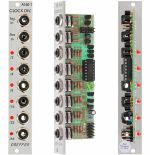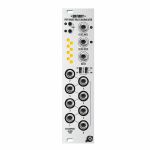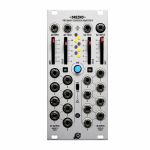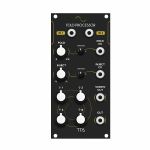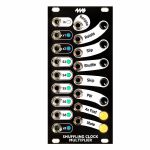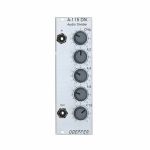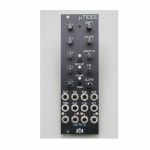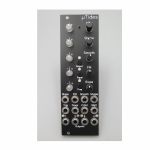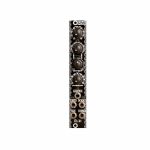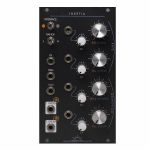安全购物
Studio equipment
Our full range of studio equipment from all the leading equipment and software brands. Guaranteed fast delivery and low prices.
安全购物
DJ equipment
Our full range of DJ equipment from all the leading equipment and software brands. Guaranteed fast delivery and low prices. Visit Juno DJ
Filter
Stock
Equipment
Format
Brand
Featured
Price
Tags
Tags: Frequency divider module
Products tagged as Frequency divider module
Items 1 to 13 of 13 on page 1 of 1
Doepfer A-160-2 Clock/Trigger Divider II Module (silver) (clock modulator/frequency divider synth module)
Cat: 671576 Rel: 29 Nov 17
Enhanced clock divider with multiple dividing factors - 4HP
Notes: Module A-160-2 is an enhanced version of the standard clock divider A-160. The module is a frequency divider for clock/trigger/gate signals, designed to be a source of lower frequencies, particularly for rhythm uses. The Clock input will take any digital signal from, eg. LFO, MIDI sync, or the gate from a MIDI-CV interface. At the outputs, you have access to three sets of seven different sub-divided clock signals, from half the clock frequency down to 1/128. The low/high levels of the output signals are 0V and about +10V.
The A-160-2 also has a reset input. Whenever a reset signal is sensed, all outputs are set to certain levels which depend upon the selected mode.
These are the most important features of the module:
Three different sets of dividing factors, selected by a three-position switch at the front panel:
- Power of two: 2, 4, 8, 16, 32, 64, 128
- Prime numbers: 2, 3, 5, 7, 11, 13, 17
- Integer: 2, 3, 4, 5, 6, 7, 8
Two output modes, selected by a two-position switch at the front panel:
- Gate mode: outputs act like the outputs of typical binary dividers
- Trigger mode: in this mode the outputs are AND-wired with the clock signal (i.e. the clock pulsewidth affects the pulsewidth of the outputs)
- Clock edge type selected by a jumper on the pc board:
- Positive: the rising edge of the clock signal triggers the state change of the outputs
- Negative: the falling edge of the clock signal triggers the state change of the outputs
Reset behaviour by two jumpers on the pc board:
- Level triggered: the level at the Reset input triggers the Reset
- Edge triggered: the edge of the signal at the Reset input triggers the Reset
- Positive: a high level (> 2.5V) or the rising edge at the Reset input triggers the Reset
- Negative: a low level (< 1 V) or the falling edge at the Reset input triggers the Reset
Output polarity selected by a jumper on the pc board:
- Positive: non-inverted outputs
- Negative: all seven outputs are inverted
Width: 4HP / 20mm
Depth: 35mm (Measured from the rear side of the front panel)
Current: +12V: +50mA, -12V: -0mA
… Read moreThe A-160-2 also has a reset input. Whenever a reset signal is sensed, all outputs are set to certain levels which depend upon the selected mode.
These are the most important features of the module:
Three different sets of dividing factors, selected by a three-position switch at the front panel:
- Power of two: 2, 4, 8, 16, 32, 64, 128
- Prime numbers: 2, 3, 5, 7, 11, 13, 17
- Integer: 2, 3, 4, 5, 6, 7, 8
Two output modes, selected by a two-position switch at the front panel:
- Gate mode: outputs act like the outputs of typical binary dividers
- Trigger mode: in this mode the outputs are AND-wired with the clock signal (i.e. the clock pulsewidth affects the pulsewidth of the outputs)
- Clock edge type selected by a jumper on the pc board:
- Positive: the rising edge of the clock signal triggers the state change of the outputs
- Negative: the falling edge of the clock signal triggers the state change of the outputs
Reset behaviour by two jumpers on the pc board:
- Level triggered: the level at the Reset input triggers the Reset
- Edge triggered: the edge of the signal at the Reset input triggers the Reset
- Positive: a high level (> 2.5V) or the rising edge at the Reset input triggers the Reset
- Negative: a low level (< 1 V) or the falling edge at the Reset input triggers the Reset
Output polarity selected by a jumper on the pc board:
- Positive: non-inverted outputs
- Negative: all seven outputs are inverted
Width: 4HP / 20mm
Depth: 35mm (Measured from the rear side of the front panel)
Current: +12V: +50mA, -12V: -0mA
2 in stock $98.02
Click for better price!
or call +44 20 7424 1960
quote 671576
quote 671576
Doepfer A-160-1 Clock/Trigger Divider Module (clock modulator synth module)
Cat: 577765 Rel: 10 Sep 19
Frequency divider for clock, trigger & gate signals - 4HP
Notes: Module A-160 is a frequency divider for clock/trigger/gate signals, designed to be a source of lower frequencies, particularly for rhythm uses. The Trigger input will take clock signals from, e.g. an LFO, MIDI sync, or the gate from a MIDI-CV interface.
At the outputs, you have access to the sub-divided clock signals, from half the clock frequency down to 1/64. The low/high levels of the output signals are 0V and about +10V.
The A-160 also has a reset input. Whenever a reset signal is sensed, all outputs are set to zero, until the reset voltage disappears.
The Clock Divider can be used in combination with the A-161 Clock Sequencer to produce stepped sequences with a length of from one to eight events.
… Read moreAt the outputs, you have access to the sub-divided clock signals, from half the clock frequency down to 1/64. The low/high levels of the output signals are 0V and about +10V.
The A-160 also has a reset input. Whenever a reset signal is sensed, all outputs are set to zero, until the reset voltage disappears.
The Clock Divider can be used in combination with the A-161 Clock Sequencer to produce stepped sequences with a length of from one to eight events.
1 in stock $62.56
NANO Modules ONA Analogue Multifunction Oscilator Module (clock generator/CV modulation/frequency divider/LFO/oscillator synth module)
Cat: 796145 Rel: 20 Nov 20
clock generator / CV modulation / frequency divider / LFO / oscillator synth module
Notes: A warm and deep sound source you can rely on
A flexible and warm Analog Multifunction Oscillator, rich in harmonics. Excellent for performance use!
ONA can work as an Audio Oscillator or as a Low Frequency Modulator and it provides control over all its parameters, making it a versatile, deep and easy-to-use oscillator.
Thanks to its triangle-core oscillator and wave-shapers you can choose between a big palette of output waveforms to give shape to your ideas.
Classic Waveforms. Sine, Triangle, Saw and Square.
2 Complex Waveforms with Pulse Width Modulation.
2 Sub-Waveforms to add some bass sounds easily.
Blend them to give unlimited depth to your sound!
… Read moreA flexible and warm Analog Multifunction Oscillator, rich in harmonics. Excellent for performance use!
ONA can work as an Audio Oscillator or as a Low Frequency Modulator and it provides control over all its parameters, making it a versatile, deep and easy-to-use oscillator.
Thanks to its triangle-core oscillator and wave-shapers you can choose between a big palette of output waveforms to give shape to your ideas.
Classic Waveforms. Sine, Triangle, Saw and Square.
2 Complex Waveforms with Pulse Width Modulation.
2 Sub-Waveforms to add some bass sounds easily.
Blend them to give unlimited depth to your sound!
1 in stock $158.50
Click for better price!
or call +44 20 7424 1960
quote 796145
quote 796145
Xaoc Devices Erfurt 1989 Binary Phase Akkumulator Module (clock generator/digital/expander/frequency divider/oscillator synth module)
Cat: 846596 Rel: 27 Apr 22
A digital module that may be used as an 8-output clock and audio frequency divider, a bi-directional binary counter, or a component of the Leibniz binary system.
Notes: Creatively inspiring business from Xaoc as usual. The Erfurt is a digital phase accumulator, digital oscillator, binary counter or clock/audio frequency divider. Versatile stuff.
Supplier's Notes:
Xaoc Devices Erfurt is a digital module that may be used as an 8-output clock and audio frequency divider, a bi-directional binary counter, or a component of the Leibniz binary system, i.e. a programmable digital oscillator.
Erfurt features an 8-bit register which holds its current state: an 8-bit number representing digital values from 0 to 255. The state is available at the front panel via eight binary (5V gate) outputs and reflected by the 8 status LEDs. There are three clock inputs: one incrementing the state at each impulse, one decrementing, and one resetting the state to zero. The state may also be changed manually with two buttons.
When operating alone, the state of Erfurt changes by 1 at each impulse from the clock inputs, so that it counts from 0 to 255 in a cycle (modulo 256). This yields the signal frequency divided by 2, 4, 8, etc. up to 128, available at individual bit outputs. Depending on which clock input is used, the clock patterns correspond to the so called mathematical or musical divisions of the rhythm.
With two different clocks patched to the inputs, the counter alternately increases and decreases its state, and ultimately it counts with a rate proportional to the frequency difference between the clocks. A third clock patched to the Reset input may be used to shorten the sequence thus making the cycle incomplete for even more rhythmic diversity.
When there is a Leibniz data source connected at the back (even as simple as Lipsk), the state increases or decreases in larger steps, depending on the data present at the Leibniz bus (eg. the value programmed by the Lipsk buttons). The counter overflows quicker, and produces more complex patterns.
The state of the counter may be used as a phase input to a digital wave table. Connected to other Leibniz modules, Erfurt may play various roles, eg. it may scan waveshapes in Jena, produce stepped voltages useful for making interesting glissandi with Drezno and any VCO, generate gate patterns animating the spectrum of Odessa harmonic banks, spawn pseudo-chaotic sequences when fed back to Lipsk, etc. Since Erfurt is based on CMOS logic (no CPU!), it can be clocked at very high frequencies (exceeding audio rate), therefore some selection switches are provided for clock pre-scaling.
Dimensions:
6 HP
Current Draw:
25 mA +12V
30 mA -12V
0 mA 5V
… Read moreSupplier's Notes:
Xaoc Devices Erfurt is a digital module that may be used as an 8-output clock and audio frequency divider, a bi-directional binary counter, or a component of the Leibniz binary system, i.e. a programmable digital oscillator.
Erfurt features an 8-bit register which holds its current state: an 8-bit number representing digital values from 0 to 255. The state is available at the front panel via eight binary (5V gate) outputs and reflected by the 8 status LEDs. There are three clock inputs: one incrementing the state at each impulse, one decrementing, and one resetting the state to zero. The state may also be changed manually with two buttons.
When operating alone, the state of Erfurt changes by 1 at each impulse from the clock inputs, so that it counts from 0 to 255 in a cycle (modulo 256). This yields the signal frequency divided by 2, 4, 8, etc. up to 128, available at individual bit outputs. Depending on which clock input is used, the clock patterns correspond to the so called mathematical or musical divisions of the rhythm.
With two different clocks patched to the inputs, the counter alternately increases and decreases its state, and ultimately it counts with a rate proportional to the frequency difference between the clocks. A third clock patched to the Reset input may be used to shorten the sequence thus making the cycle incomplete for even more rhythmic diversity.
When there is a Leibniz data source connected at the back (even as simple as Lipsk), the state increases or decreases in larger steps, depending on the data present at the Leibniz bus (eg. the value programmed by the Lipsk buttons). The counter overflows quicker, and produces more complex patterns.
The state of the counter may be used as a phase input to a digital wave table. Connected to other Leibniz modules, Erfurt may play various roles, eg. it may scan waveshapes in Jena, produce stepped voltages useful for making interesting glissandi with Drezno and any VCO, generate gate patterns animating the spectrum of Odessa harmonic banks, spawn pseudo-chaotic sequences when fed back to Lipsk, etc. Since Erfurt is based on CMOS logic (no CPU!), it can be clocked at very high frequencies (exceeding audio rate), therefore some selection switches are provided for clock pre-scaling.
Dimensions:
6 HP
Current Draw:
25 mA +12V
30 mA -12V
0 mA 5V
1 in stock $153.28
Click for better price!
or call +44 20 7424 1960
quote 846596
quote 846596
Doepfer A-160-2v Clock/Trigger Divider II Vintage Edition Module (black) (clock modulator/frequency divider synth module)
Cat: 864696 Rel: 14 Mar 22
Module A-160-2 is an enhanced version of the standard clock divider A-160.
Notes: Module A-160-2V is an enhanced version of the standard clock divider A-160. The module is a frequency divider for clock/trigger/gate signals, designed to be a source of lower frequencies, particularly for rhythm uses.
The Clock input will take any digital signal from, eg., an LFO, MIDI sync, or the gate from a MIDI-CV interface. At the outputs, you have access to three sets of seven different sub-divided clock signals, from half the clock frequency down to 1/128. The low/high levels of the output signals are 0V and about +10V.
The A-160-2V also has a reset input. Whenever a reset signal is sensed, all outputs are set to certain levels which depend upon the selected mode.
HP : 4
… Read moreThe Clock input will take any digital signal from, eg., an LFO, MIDI sync, or the gate from a MIDI-CV interface. At the outputs, you have access to three sets of seven different sub-divided clock signals, from half the clock frequency down to 1/128. The low/high levels of the output signals are 0V and about +10V.
The A-160-2V also has a reset input. Whenever a reset signal is sensed, all outputs are set to certain levels which depend upon the selected mode.
HP : 4
5 in stock $108.45
Click for better price!
or call +44 20 7424 1960
quote 864696
quote 864696
Xaoc Devices Drezno II 1989 Binary Conversion Komputor Module (comparator/CV modulation/distortion/frequency divider/logic/quantizer/sample & hold/waveshaper synth module)
Cat: 945630 Rel: 10 Nov 23
An improved version of the original Drezno module in 12HP.
Notes: Part of Xaoc's Leibniz Binary Subsystem, the updated Drezno ADC/DAC module builds on the original with higher resolution converters, allowing you to use it for pitch quantisation.
Supplier's Notes:
Drezno II is an improved version of the original Drezno module. It is an essential member of the 8-bit Xaoc Devices Leibniz Binary Subsystem. The Leibniz subsystem is a family of modules that operate on 8 binary (two-state, on/off) signals. These signals are arranged as 8 bits of digital data and may represent analogue signals and voltages, or they may be whatever you want them to be (clocks, gates, rhythms, etc.).
Drezno features an ADC (analogue-to-digital-converter) and DAC (digital-to-analogue-converter), allowing it to act as an analog front-end of the system. In other words, Drezno allows one to convert analogue signals and CVs into digital numbers, as well as to obtain analogue signals back from some other digital numbers (or 8 binary signals). Between these two conversions there is a whole universe of digital shenanigans waiting to happen resulting in all kinds of signal transformations and modulations.
Both (ADC and DAC) sections of Drezno can work independently, or they can be linked. Input and output range of analogue signals may be adjusted using Gain and Offset sliders. Individual bit outputs (for the ADC) and inputs (DAC) allow for extensive cross-patching and the creation of complex waveforms and rhythms. A very fast clock (up to 2MHz) at which the conversions are performed may be replaced with any external clock (for each section separately).
Compared to its predecessor, Drezno II uses new converters of much higher resolution which results in much lower noise floor and higher accuracy. The lower bits are much more stable than before. It is easy now to use Drezno for quantizing pitch voltages with accurate results with 128 or 256 semitone steps. Potentiometer ranges are factory calibrated for precise chromatic scale. A new switch on the front panel allows the user to select the calibrated range of 10Vpp or 20Vpp, so that the lowest bit or the second bit correspond to 1 semitone.
Technical details
Eurorack synth compatible
12hp, skiff friendly
Current draw: +80mA/-50mA
Reverse power protection
… Read moreSupplier's Notes:
Drezno II is an improved version of the original Drezno module. It is an essential member of the 8-bit Xaoc Devices Leibniz Binary Subsystem. The Leibniz subsystem is a family of modules that operate on 8 binary (two-state, on/off) signals. These signals are arranged as 8 bits of digital data and may represent analogue signals and voltages, or they may be whatever you want them to be (clocks, gates, rhythms, etc.).
Drezno features an ADC (analogue-to-digital-converter) and DAC (digital-to-analogue-converter), allowing it to act as an analog front-end of the system. In other words, Drezno allows one to convert analogue signals and CVs into digital numbers, as well as to obtain analogue signals back from some other digital numbers (or 8 binary signals). Between these two conversions there is a whole universe of digital shenanigans waiting to happen resulting in all kinds of signal transformations and modulations.
Both (ADC and DAC) sections of Drezno can work independently, or they can be linked. Input and output range of analogue signals may be adjusted using Gain and Offset sliders. Individual bit outputs (for the ADC) and inputs (DAC) allow for extensive cross-patching and the creation of complex waveforms and rhythms. A very fast clock (up to 2MHz) at which the conversions are performed may be replaced with any external clock (for each section separately).
Compared to its predecessor, Drezno II uses new converters of much higher resolution which results in much lower noise floor and higher accuracy. The lower bits are much more stable than before. It is easy now to use Drezno for quantizing pitch voltages with accurate results with 128 or 256 semitone steps. Potentiometer ranges are factory calibrated for precise chromatic scale. A new switch on the front panel allows the user to select the calibrated range of 10Vpp or 20Vpp, so that the lowest bit or the second bit correspond to 1 semitone.
Technical details
Eurorack synth compatible
12hp, skiff friendly
Current draw: +80mA/-50mA
Reverse power protection
3 in stock $249.23
Tiptop Audio Fold Processor Wave Multiplier & Sub-Octave Generator Module (black) (frequency divider/waveshaper synth module)
Cat: 794940 Rel: 21 Oct 20
waveshaper / frequency divider synth module
Notes: The Fold Processor is a voltage-controlled wave multiplier and sub-octave generator. The circuit is based on a classic diode design that adds odd harmonics by folding the incoming signal, followed by subdivided square waves.
The wave folder creates new waveforms from standard sine, triangle, sawtooth, and square waves and includes a CV input with an attenuator, making it very easy to create beautifully animated folding sounds. Adjustable voltage-controlled Inject alters the bias point creating an even wider palette of sounds.
The subdivide generator squares the fold output generating 4 more sounds spaced one octave apart, each with its own gain knob and mixed to the Subdivide output jack. Mixing the four can create anything from discordant square wave swarms to sweet harmonic oscillator stacks, from a stable square version of the folded wave to freaky PLL-like glitched slides.
Overall results can sound evil at times and sweet at others, a true multi-faced devil.
Size: 12HP
Depth: 31mm
Power: +12V 60ma / -12V 55ma
… Read moreThe wave folder creates new waveforms from standard sine, triangle, sawtooth, and square waves and includes a CV input with an attenuator, making it very easy to create beautifully animated folding sounds. Adjustable voltage-controlled Inject alters the bias point creating an even wider palette of sounds.
The subdivide generator squares the fold output generating 4 more sounds spaced one octave apart, each with its own gain knob and mixed to the Subdivide output jack. Mixing the four can create anything from discordant square wave swarms to sweet harmonic oscillator stacks, from a stable square version of the folded wave to freaky PLL-like glitched slides.
Overall results can sound evil at times and sweet at others, a true multi-faced devil.
Size: 12HP
Depth: 31mm
Power: +12V 60ma / -12V 55ma
1 in stock $149.91
Click for better price!
or call +44 20 7424 1960
quote 794940
quote 794940
4ms SCM Plus Shuffling Clock Multiplier Module (clock generator/clock modulator/frequency divider synth module)
Cat: 901317 Rel: 29 Sep 22
The SCM Plus is a clock multiplier with eight gate outputs and complex beat manipulation features.
Notes: The SCM Plus is a clock multiplier with eight gate outputs and complex beat manipulation features. It combines the classic Shuffling Clock Multiplier (SCM) and SCM Breakout (SCMBO) into a single module using higher precision hardware than its predecessors.
Specs:
Electrical and Mechanical Specifications
12HP Eurorack format module
0.95" (24mm) maximum depth (includes power cable)
16-pin Eurorack power header
Power consumption
+12V: 52mA max
-12V: 15mA
Clock Input
2.5V threshold
40kHz maximum
Clock Outputs
12V gate outputs, rise/fall time approximately 1us
40kHz maximum
Jitter (x1 output): max 30us < 120BPM, max 5us >= 120BPM
Latency (clock in to x1 output): 8us worst-case, 3.5us typical
CV Inputs:
Rotate, Slip: Knob attenuates jack signal. Full range: 0V to +3.3V
Shuffle, Skip, PW: Knob offsets jack signal. Full range: -5V to +5V
Gate Inputs:
4x Fast, Mute: 2.5V threshold. Button toggles state.
… Read moreSpecs:
Electrical and Mechanical Specifications
12HP Eurorack format module
0.95" (24mm) maximum depth (includes power cable)
16-pin Eurorack power header
Power consumption
+12V: 52mA max
-12V: 15mA
Clock Input
2.5V threshold
40kHz maximum
Clock Outputs
12V gate outputs, rise/fall time approximately 1us
40kHz maximum
Jitter (x1 output): max 30us < 120BPM, max 5us >= 120BPM
Latency (clock in to x1 output): 8us worst-case, 3.5us typical
CV Inputs:
Rotate, Slip: Knob attenuates jack signal. Full range: 0V to +3.3V
Shuffle, Skip, PW: Knob offsets jack signal. Full range: -5V to +5V
Gate Inputs:
4x Fast, Mute: 2.5V threshold. Button toggles state.
1 in stock $177.27
Click for better price!
or call +44 20 7424 1960
quote 901317
quote 901317
Doepfer A-115 Audio Divider Module (frequency divider synth module)
Cat: 698545 Rel: 15 Aug 18
Fourfold frequency divider for creating up to four sub-octaves - 8HP
Notes: Module A-115 is a four-way frequency divider. The frequency of a signal at the input is halved (half frequency = first sub-octave), quartered (1/4 frequency = second sub-octave), and so on. In this way, the DIVIDER produces four sub-octaves (F/2 down to F/16).
At the output, the A-115 produces a summed mix of the original and the four sub-octaves. There are attenuators to control the amount (i.e. Amplitude) of the original signal and each of the sub-octaves.
Bear in mind that the sub-octaves output by the A-115 are all true square waves. At the output there are always four square waves and the original signal available.
… Read moreAt the output, the A-115 produces a summed mix of the original and the four sub-octaves. There are attenuators to control the amount (i.e. Amplitude) of the original signal and each of the sub-octaves.
Bear in mind that the sub-octaves output by the A-115 are all true square waves. At the output there are always four square waves and the original signal available.
1 in stock $65.69
Click for better price!
or call +44 20 7424 1960
quote 698545
quote 698545
Michigan Synth Works MicroTides Version 2 Tidal modulator Module (black) (clock generator/digital/envelope generator/frequency divider/function generator/LFO/oscillator synth module)
Cat: 802220 Rel: 07 Jan 21
Micro tidal modulator module in 8HP.
Notes: 8HP Tides version 2
Fully calibrated.
… Read moreFully calibrated.
1 in stock $191.88
Click for better price!
or call +44 20 7424 1960
quote 802220
quote 802220
Michigan Synth Works MicroTides Version 2 Tidal Modulator Module With LED Pots (black) (clock generator/digital/envelope generator/frequency divider/function generator/LFO/oscillator synth module)
Cat: 802222 Rel: 07 Jan 21
A tidal modulator module with LEDs in 8HP.
Notes: 8HP Tides version 2
Fully calibrated.
With LED Pots for the attenuverters.
… Read moreFully calibrated.
With LED Pots for the attenuverters.
1 in stock $201.26
Click for better price!
or call +44 20 7424 1960
quote 802222
quote 802222
Zlob Modular Foldiplier Odd/Even Harmonics Generator Module (frequency divider/waveshaper synth module)
Cat: 964623 Rel: 05 Oct 23
Odd/even harmonics generator module with feedback - 4HP.
Notes: The Foldiplier is a 4hp odd/even harmonics generator with 2 different oscillating feedback paths. The folding core of the design originates from the odd harmonics (middle)section of the Serge Wave Multiplier. But the Foldiplier adds voltage control over the symmetry and offset as well as a switch for feedback, jumper selectable between, a transistor based oscillating fuzz inspired by the Hemmo Bazz Fuss with a lot more low harmonic content and a passive oscillating half wave rectification circuit with more high harmonic content. When these feedback oscillations mix with an incoming waveform some unpredictable and unique nonlinear timbres can be achieved. The module can also be used as a no-input experimental oscillator with the feedback switch engaged. All diodes in the module are silicon.
The Fold knob controls the amount of times the waveform is folded in on its self (indicated by the red led window below the knob). The C.V. knob below is an attenuator for incoming control voltage corresponding to the Fold jack(indicated by the red led window above the jack, it only responds to positive voltage). So, the Fold knob acts like an initial amount of folding depending on its position. For example, with the Fold knob fully clockwise you can get even more folds with a control voltage in at the Fold jack. The Offset knob controls how much positive DC voltage(0 to 5v, clockwise) or negative(0 to -5v counter clockwise) DC voltage(indicated by the led window above the Offset jack, red for positive, yellow for negative) injected into the waveform via the Symmetry knob. With the Offset knob position at noon(0v) there will little effect from the Symmetry knob. The Offset jack is expecting +5v to -5v with knob position at noon to scan through the positive and negative voltage. The Symmetry knob controls the amount of negative or positive offset voltage(dependent on the Offset knob) mixed with the waveform(indicated by the yellow led window above the Symmetry jack). If positive voltage is mixed with incoming waveform more folds will occur on the positive troughs of the waveform, likewise, when negative voltage is introduced more folds happen on the negative troughs. This part of the circuit can also be broken down by thinking of the Offset as a voltage controlled crossfader swinging between positive and negative voltages into a VCA controlled by the Symmetry knob and jack. When a voltage is present at the Symmetry jack the Symmetry knob becomes an attenuator. The Symmetry jack only responds to positive voltage.
Width: 4hp
Panel Material: Double Sided PCB panel with Classic and Soulless
Reverse Power Protected
Current Consumption: +12v: 40mA, -12v: 35mA
Depth: 47mm or 1.75"
All through-hole build
Ships with M3 black nylon screws
Expandable: No
… Read moreThe Fold knob controls the amount of times the waveform is folded in on its self (indicated by the red led window below the knob). The C.V. knob below is an attenuator for incoming control voltage corresponding to the Fold jack(indicated by the red led window above the jack, it only responds to positive voltage). So, the Fold knob acts like an initial amount of folding depending on its position. For example, with the Fold knob fully clockwise you can get even more folds with a control voltage in at the Fold jack. The Offset knob controls how much positive DC voltage(0 to 5v, clockwise) or negative(0 to -5v counter clockwise) DC voltage(indicated by the led window above the Offset jack, red for positive, yellow for negative) injected into the waveform via the Symmetry knob. With the Offset knob position at noon(0v) there will little effect from the Symmetry knob. The Offset jack is expecting +5v to -5v with knob position at noon to scan through the positive and negative voltage. The Symmetry knob controls the amount of negative or positive offset voltage(dependent on the Offset knob) mixed with the waveform(indicated by the yellow led window above the Symmetry jack). If positive voltage is mixed with incoming waveform more folds will occur on the positive troughs of the waveform, likewise, when negative voltage is introduced more folds happen on the negative troughs. This part of the circuit can also be broken down by thinking of the Offset as a voltage controlled crossfader swinging between positive and negative voltages into a VCA controlled by the Symmetry knob and jack. When a voltage is present at the Symmetry jack the Symmetry knob becomes an attenuator. The Symmetry jack only responds to positive voltage.
Width: 4hp
Panel Material: Double Sided PCB panel with Classic and Soulless
Reverse Power Protected
Current Consumption: +12v: 40mA, -12v: 35mA
Depth: 47mm or 1.75"
All through-hole build
Ships with M3 black nylon screws
Expandable: No
1 in stock $150.16
Click for better price!
or call +44 20 7424 1960
quote 964623
quote 964623
New Systems Instruments Inertia Universal Movement Simulator Module (envelope follower/envelope generator/filter/frequency divider/function generator/LFO/oscillator/slew limiter synth module)
Cat: 929653 Rel: 20 Mar 23
An universal movement smulator module in 14HP.
Notes: Eurorack and Newtonian physics meet in this clever 'movement simulator' module, capable of acting as a VCO, LFO, envelope generator, filter and more.
Supplier's Notes:
Inertia is a universal movement simulator. It generates output curves from input stimuli and the weight of its own motion-that is, its inertia.
Just as Newton described the motion of the planets and the motion of earthly bodies with a single set of laws, so too Inertia brings together several seemingly disparate musical functions with a single, elegant abstraction. Inertia can be used as:
A rich oscillator with 5+ octaves of temperature-compensated V/O and CV over skew
A quadrature sine wave oscillator
An LFO divider
A filter with controllable, skewable resonance, from a light touch to screaming glitches
An envelope generator with nuanced, natural sounding control over the minutiae of the attack and decay stages
An intuitive sine wave skew LFO
A phase locked loop
A voltage controlled exponential slew limiter
A slew limiter with controllable overshoot and settling (like a Wogglebug)
A percussive sound generator
And more uses that we haven't yet discovered
Inertia achieves all this complexity with simple controls. The exponential rate at which the output rises and falls can be set by the rise and fall controls. Inertia then follows an input signal according to these two rates, producing a first order and second order output. But things get interesting with the momentum controls. When you add some rise or fall momenta, the output signal exceeds its target in that direction before returning to its destination. With momentum, you can create ADSR-like envelopes, skewed filter resonance, etc. When momentum is all the way up, Inertia self-oscillates, acting like an LFO or VCO.
In addition to rise/fall mode, Inertia can be set to value/skew mode, in which these same parameters are controlled as overall frequency, plus the skew between rise and fall rates, and overall momentum, plus the skew between rise and fall momenta. An LED colour and position indicates which mode is being used.
Inertia is inspired by the Dual Universal Slope Generator (DUSG), invented by Serge Tcherepnin for his Serge synthesizer system. Rather than duplicate the DUSG in a new wrapper, Inertia builds on the innovative, abstract impulse at the heart of the DUSG to create something different and new. This all-analogue circuit is original both in concept and execution, but it grows in rich soil.
Size: 14HP
Depth: 25mm
Power Consumption +12V 72mA, -12V 72mA
Timing Range: 50s-7ms (low), 7Hz-50kHz (high)
Tuning Accuracy: ~5 octaves
Self-Oscillation Range: -6V-+6V peak
Full I/O Range: -9.5V-+9.5V peak
Input Impedance: 50kO
Output Impedance: 150O
Output Drive: 2kO (min), 20kO+ (ideal)
… Read moreSupplier's Notes:
Inertia is a universal movement simulator. It generates output curves from input stimuli and the weight of its own motion-that is, its inertia.
Just as Newton described the motion of the planets and the motion of earthly bodies with a single set of laws, so too Inertia brings together several seemingly disparate musical functions with a single, elegant abstraction. Inertia can be used as:
A rich oscillator with 5+ octaves of temperature-compensated V/O and CV over skew
A quadrature sine wave oscillator
An LFO divider
A filter with controllable, skewable resonance, from a light touch to screaming glitches
An envelope generator with nuanced, natural sounding control over the minutiae of the attack and decay stages
An intuitive sine wave skew LFO
A phase locked loop
A voltage controlled exponential slew limiter
A slew limiter with controllable overshoot and settling (like a Wogglebug)
A percussive sound generator
And more uses that we haven't yet discovered
Inertia achieves all this complexity with simple controls. The exponential rate at which the output rises and falls can be set by the rise and fall controls. Inertia then follows an input signal according to these two rates, producing a first order and second order output. But things get interesting with the momentum controls. When you add some rise or fall momenta, the output signal exceeds its target in that direction before returning to its destination. With momentum, you can create ADSR-like envelopes, skewed filter resonance, etc. When momentum is all the way up, Inertia self-oscillates, acting like an LFO or VCO.
In addition to rise/fall mode, Inertia can be set to value/skew mode, in which these same parameters are controlled as overall frequency, plus the skew between rise and fall rates, and overall momentum, plus the skew between rise and fall momenta. An LED colour and position indicates which mode is being used.
Inertia is inspired by the Dual Universal Slope Generator (DUSG), invented by Serge Tcherepnin for his Serge synthesizer system. Rather than duplicate the DUSG in a new wrapper, Inertia builds on the innovative, abstract impulse at the heart of the DUSG to create something different and new. This all-analogue circuit is original both in concept and execution, but it grows in rich soil.
Size: 14HP
Depth: 25mm
Power Consumption +12V 72mA, -12V 72mA
Timing Range: 50s-7ms (low), 7Hz-50kHz (high)
Tuning Accuracy: ~5 octaves
Self-Oscillation Range: -6V-+6V peak
Full I/O Range: -9.5V-+9.5V peak
Input Impedance: 50kO
Output Impedance: 150O
Output Drive: 2kO (min), 20kO+ (ideal)
1 in stock $321.20
Click for better price!
or call +44 20 7424 1960
quote 929653
quote 929653
Items 1 to 13 of 13 on page 1 of 1




